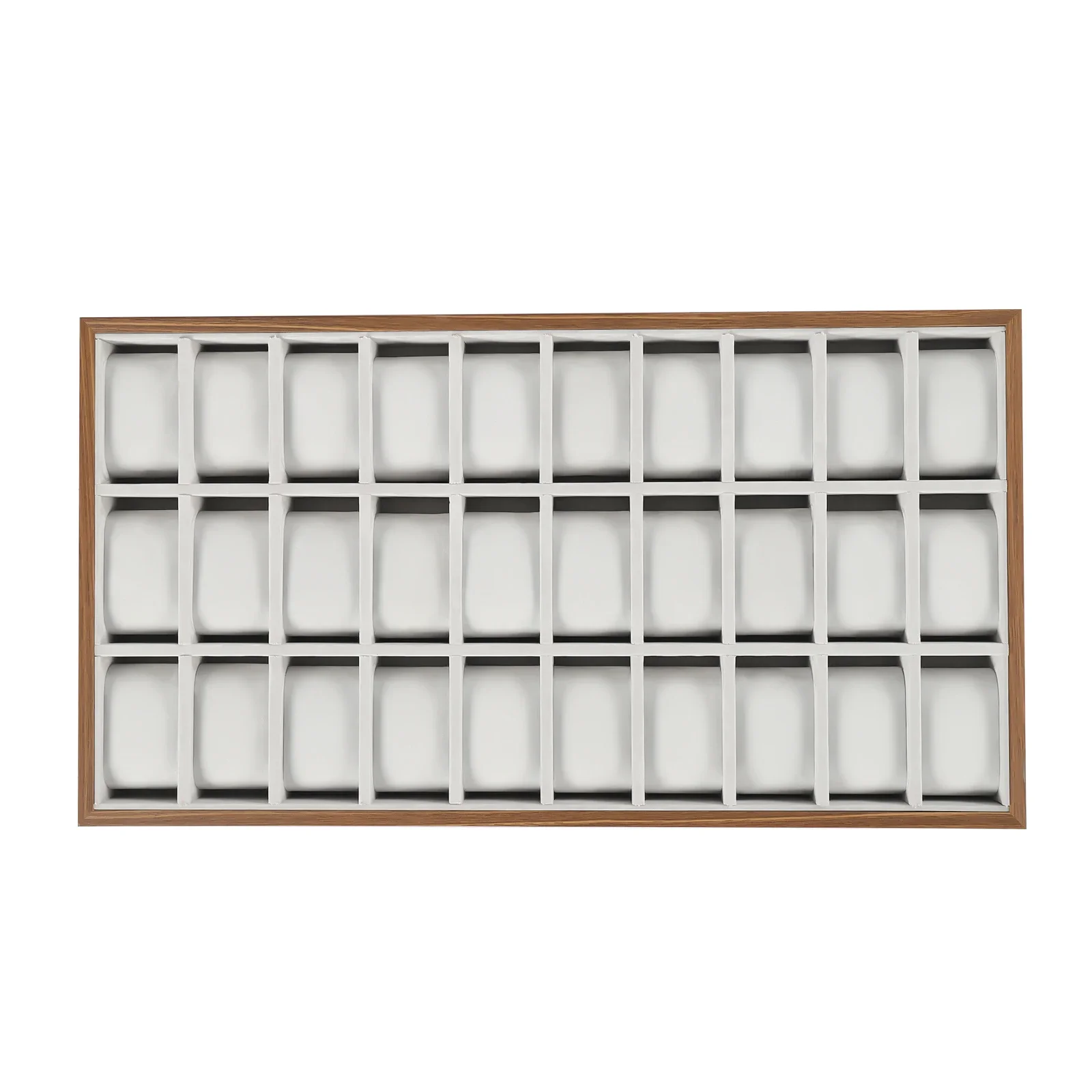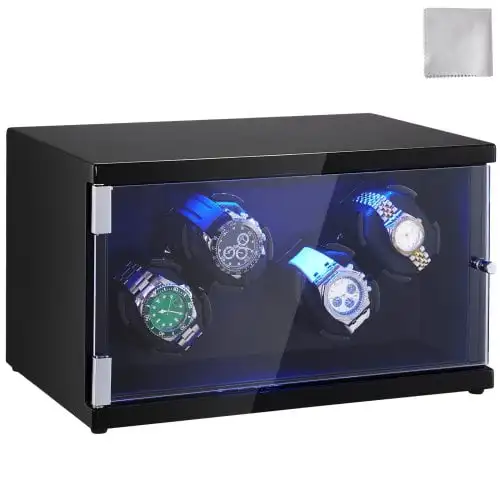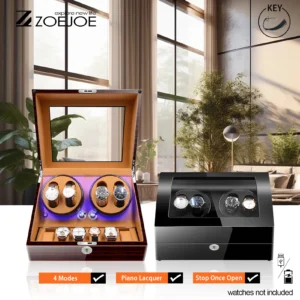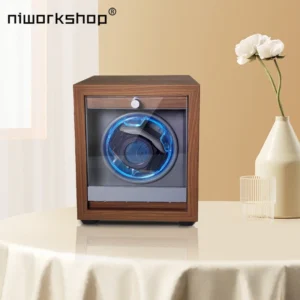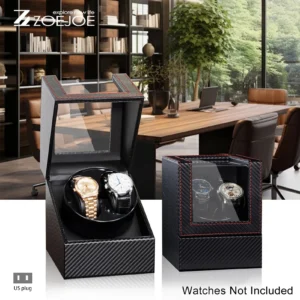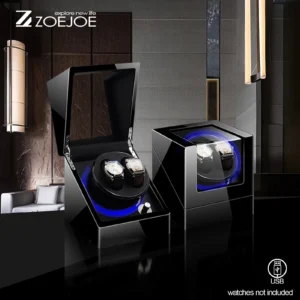Understanding Watch Winder Settings: Turns Per Day (TPD) vs Speed
When it comes to watch winders, “speed” isn’t measured the way you might expect. Instead of revolutions per minute or miles per hour, watch winders operate using a measurement called Turns Per Day (TPD). This represents how many complete 360° rotations the winder performs over a 24-hour period.
Watch winders serve a vital purpose for automatic watch owners. These clever devices keep your timepiece wound when you’re not wearing it. This is particularly important because automatic watches rely on motion to stay powered – specifically, the natural movements of your wrist throughout the day turn an internal rotor that winds the mainspring.
When your beautiful automatic watch sits unworn in a drawer, that motion stops, and eventually, so will your watch. A properly set watch winder mimics the motion of your wrist, ensuring your timepiece remains accurately wound and ready to wear at a moment’s notice.
Getting the TPD setting right is crucial for your watch’s maintenance and longevity. Too few turns, and your watch may stop or lose accuracy; too many might not damage modern watches but wastes energy unnecessarily.
The correct settings depend on two key parameters: the TPD rate and the winding direction. These settings vary between different watch brands and models because each watch movement has specific winding requirements based on its design.
Most automatic watches need somewhere between 650-950 TPD to stay properly wound – roughly equivalent to the movement your watch would experience during a typical day of wear. Understanding these watch winder motor specifications provides the foundation for proper watch care.
Before diving deeper into specific settings, it’s important to understand that watch winders don’t spin continuously. They operate in intermittent cycles that better simulate natural wrist movements, making comprehensive TPD watch winder knowledge essential for any serious collector.
What is Turns Per Day (TPD) and Why Does It Matter?
Turns Per Day (TPD) refers to the number of complete 360-degree rotations that a watch winder performs within a 24-hour period. This measurement is crucial because each automatic watch has a specific winding requirement based on its internal movement or caliber.
Think of TPD like fuel for your car – different models require different amounts to run efficiently. Some watch movements need relatively few rotations to maintain optimal power, while others demand significantly more.
The importance of setting the correct TPD cannot be overstated:
- Power reserve maintenance: The right TPD ensures your watch maintains adequate power reserve, keeping it running accurately when not in use
- Mechanical preservation: Proper winding helps circulate lubricants throughout the movement, preventing oil from settling and parts from stiffening
- Performance optimization: Correct winding maintains the watch’s accuracy and timekeeping performance
- Prevention of under-winding: Insufficient TPD can lead to power loss and stopped watches
- Energy efficiency: Using the optimal TPD setting avoids wasted electricity from excessive winding
Most automatic watches fall within a TPD range of 650-1200. Simpler movements often need fewer rotations (around 650-800 TPD), while more complex watches with additional complications might require 900+ TPD to maintain proper function.
For example, many standard Rolex models function well at around 650 TPD, while certain Omega watches with co-axial escapements might need 800+ TPD for optimal performance. Understanding these differences is why having access to a comprehensive watch winder TPD settings guide is invaluable for collectors with multiple timepieces.
Understanding Winding Directions: CW, CCW, and Bi-Directional
Just as important as the TPD setting is the direction in which your watch winder rotates. Automatic watches are designed to wind in one of three possible configurations:
Clockwise (CW): The winder rotates in a clockwise direction only, matching watches designed to wind when the rotor spins clockwise.
Counter-clockwise (CCW): The winder rotates counter-clockwise only, for watches that wind when the rotor moves in this direction.
Bi-directional: The winder alternates between clockwise and counter-clockwise rotations, accommodating watches that wind in both directions.
The direction matters because of how the self-winding mechanism inside your watch is constructed. Different manufacturers design their movements with different winding systems:
| Winding Direction | Common Examples | Notes |
|---|---|---|
| Clockwise Only | Some Rolex, Tudor | These watches only wind when the rotor moves clockwise |
| Counter-clockwise Only | Some Breitling, older Omega | These models only wind when the rotor moves counter-clockwise |
| Bi-directional | Most Seiko, modern Omega, IWC | These watches wind efficiently regardless of rotor direction |
Setting the correct direction ensures winding efficiency. For instance, a clockwise-only watch on a counter-clockwise winder would receive no winding benefit at all. Meanwhile, using a bi-directional setting for any watch is generally safe, though possibly less efficient for direction-specific models.
The internal mechanics that determine winding direction vary between manufacturers, with differences in how the rotor connects to the mainspring. Some use a complex system of reduction gears while others employ a more direct connection.
For a deeper understanding of these mechanisms and their settings, the ultimate guide to automatic watch winder settings provides comprehensive information about all winding direction configurations.
How to Find Your Watch’s Correct TPD and Winding Direction
Finding the precise TPD and direction requirements for your specific timepiece is essential for proper care. Here’s how to locate this information through several reliable sources:
Watch Manual or Documentation
Your watch’s original manual often contains technical specifications including winding requirements. Look for sections titled “Technical Specifications,” “Movement,” or “Care Instructions.” Some premium watches include a card specifically detailing winder settings.
Manufacturer’s Official Website
Most watch brands maintain technical information on their websites:
* Navigate to the technical specifications or customer support section
* Search for your specific model number
* Look for details about the movement/caliber
Online Watch Winder Databases
Several reliable resources compile winding requirements:
* Wolf Winder Guide
* Orbita Database
* Watch-Wiki Movement Database
* WatchWinder.com settings tool
Contact the Manufacturer Directly
When other sources fail, reaching out to the manufacturer’s customer service department can provide definitive answers. Be prepared with your watch’s:
* Complete model name/number
* Serial number (if applicable)
* Movement/caliber information (usually printed on the movement itself)
Before beginning your search, gather essential information about your watch:
* Brand (e.g., Rolex, Omega, Seiko)
* Exact model name and reference number
* Movement information (often found on the caseback or by opening the watch)
When reviewing technical documentation, watch for terms like “rotor winding direction,” “oscillation direction,” or specific TPD requirements. Some manufacturers use proprietary terminology, so look for any references to winding specifications.
For practical guidance on implementing these settings once you’ve found them, our watch winder setup guide provides step-by-step instructions for programming various winder models.
General TPD Recommendations When Specific Data is Unavailable
Sometimes finding exact specifications for your watch proves challenging, especially for vintage pieces or less common brands. In these situations, following general guidelines based on watch type can help you select appropriate settings.
When specific data is unavailable, here are safe default recommendations:
| Watch Type | Recommended TPD Range | Direction |
|---|---|---|
| Standard automatic movements | 650-800 TPD | Bi-directional |
| High-efficiency/modern movements | 800-950 TPD | Bi-directional |
| Complicated watches (perpetual calendars, etc.) | 900-1200 TPD | Bi-directional |
| Vintage automatics (pre-1970s) | 600-750 TPD | Bi-directional |
When in doubt, it’s always safer to start with a lower TPD setting and adjust upward if necessary. A setting that’s too low might result in your watch not maintaining proper time (easily corrected), while excessively high settings waste energy and cause unnecessary wear over time.
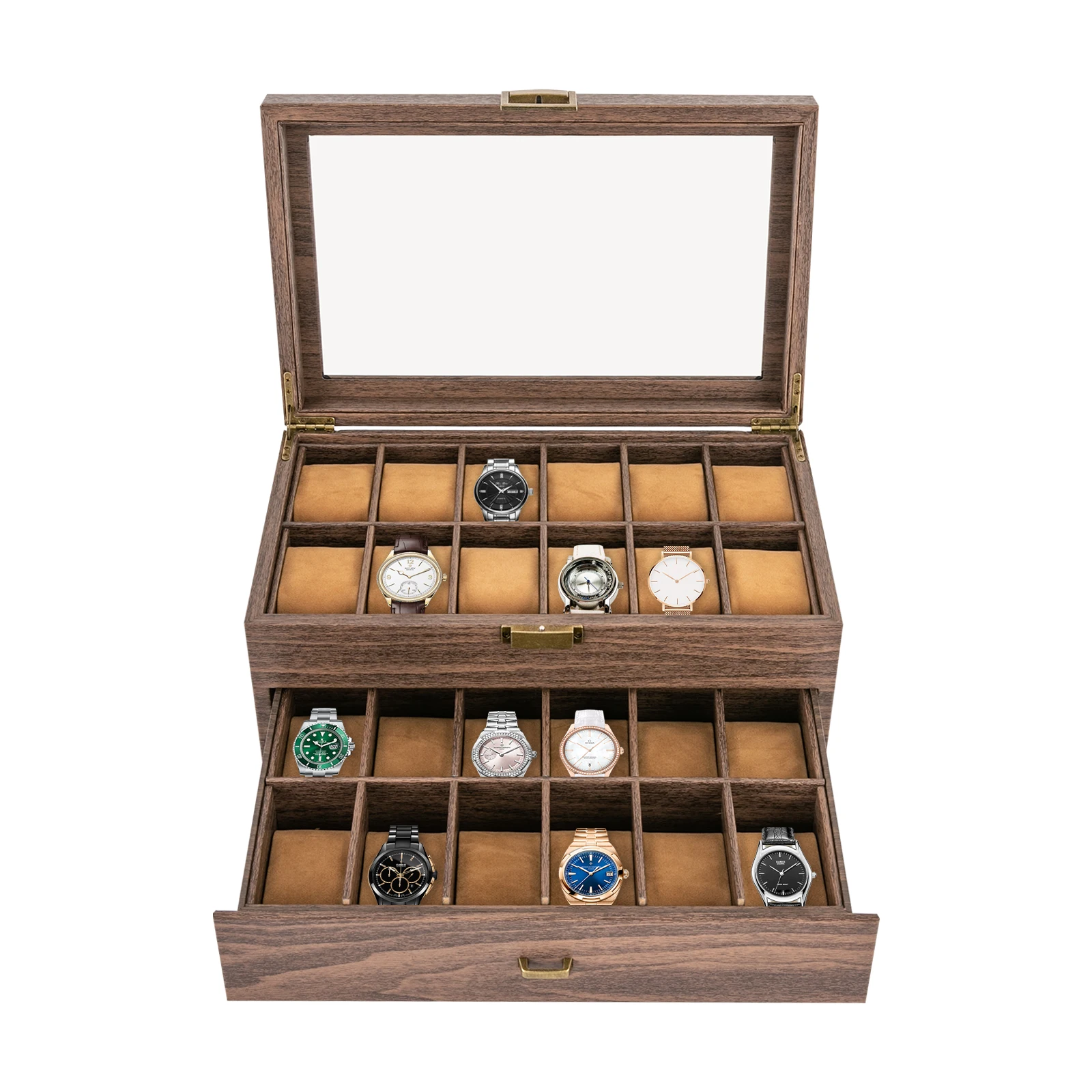
For direction settings, bi-directional rotation serves as the safest default choice. Nearly all modern automatic watches will wind effectively with bi-directional rotation, even if they’re optimized for a specific direction. Only in rare cases will a bi-directional setting be inefficient enough to warrant changing to a single-direction setting.
Watch brands typically follow certain patterns in their movement design. For example, many Swiss luxury brands use similar winding mechanisms across their collections. Watches with ETA-based movements (found in many brands) typically work well at 650-750 TPD, while watches with in-house movements might have more specific requirements.
Setting Up Your Watch Winder: Step-by-Step Guide
Follow this systematic approach to properly set up your automatic watch on a winder:
Start with a fully wound watch
Begin by manually winding your watch if it has stopped. For most automatic watches, rotate the crown clockwise 20-30 times until you feel resistance (don’t force it). This ensures the watch has enough initial power reserve to operate while you fine-tune the winder settings.Position the watch correctly
Place your watch securely on the winder cushion, making sure it’s centered and stable. The watch should fit snugly but not be compressed or strained. Most winders have adjustable cushions to accommodate different watch sizes.Select initial settings
Using the information gathered about your specific watch (or the general recommendations from the previous section):
* Set the TPD to the recommended value or start at 650 TPD if unsure
* Select bi-directional rotation unless you know your watch requires a specific direction
* If your winder has program settings, choose the intermittent rotation option rather than continuousMonitor performance for 24-48 hours
Place your watch on the winder and let it run for at least a full day. After this period, check if the watch is keeping accurate time. The best test is to set the watch precisely, run it on the winder for a full day, then check for any time loss or gain.Fine-tune if necessary
If your watch loses time or stops while on the winder, incrementally increase the TPD setting by 100-150 turns. If using a bi-directional setting doesn’t maintain power effectively, try testing a specific direction (first clockwise, then counter-clockwise if needed).Adjust for seasonal changes
Watches you wear less frequently may need slightly higher TPD settings to maintain proper function during long storage periods. For watches worn weekly, standard settings should suffice; for those worn monthly or less, consider increasing TPD by 100-150.
The quality and types of motors in watch winders can also impact performance, with premium winders offering more precise and consistent rotation patterns.
Testing and Adjusting Your Watch Winder Settings
Finding the optimal settings often requires systematic testing and adjustment. Here’s how to determine if your current settings are effective and make appropriate changes:
Signs your TPD setting is too low:
* Watch stops completely within 24-48 hours on the winder
* Watch runs significantly slow (losing minutes per day)
* Power reserve depletes quicker than expected
* Day/date functions fail to change properly at midnight
Signs your direction setting may be incorrect:
* Watch winds very inefficiently despite adequate TPD
* Minimal increase in power reserve after extended winder use
* Watch performs better when worn (with natural wrist motion) than on the winder
When adjustments are needed, follow this systematic approach:
For TPD adjustments:
* Increase settings in increments of 100-150 TPD
* Allow 24 hours of testing between adjustments
* Record results at each setting (time accuracy, power reserve)
* Stop increasing once the watch maintains accurate timeFor direction adjustments:
* If bi-directional setting is ineffective, try clockwise only
* Test for 24 hours and note performance
* If still ineffective, try counter-clockwise only
* Return to bi-directional with higher TPD if single directions don’t improve performance
Document your findings in a simple log: note the date, setting changes, and performance results. This creates a valuable reference for your specific watch’s needs and helps identify any changes in performance that might indicate service is needed.
Understanding when to use or not use watch winders for different watches in your collection can also help you develop an effective rotation strategy.
The Myth of Over-Winding Automatic Watches
Many watch enthusiasts worry about “over-winding” their automatic watches on a winder, but this concern is largely unfounded with modern timepieces.
Modern automatic watches are equipped with a slipping clutch or mainspring bridle – an ingenious mechanism that prevents the mainspring from being wound beyond its optimal tension. When the mainspring reaches full wind, this safety system allows the winding mechanism to continue turning without adding additional tension to the mainspring.
This is fundamentally different from manual-wind watches, which lack this safety feature and can potentially be damaged by excessive winding. With an automatic watch, once the mainspring is fully wound, additional rotations essentially “slip” rather than adding dangerous tension.
While excessive TPD settings won’t damage your modern automatic watch, they do:
* Waste electricity
* Create unnecessary wear on the winder motor
* Potentially cause slightly more wear to the watch’s winding mechanism over many years
For vintage automatic watches (particularly those from before the 1960s), more caution is warranted as some early self-winding movements had less sophisticated protection mechanisms. For these pieces, err on the side of lower TPD settings.
How Watch Winders Actually Work: Operation Cycles
A common misconception is that watch winders spin continuously. In reality, quality winders operate in intermittent cycles that better simulate natural wrist movement and provide more efficient winding.
Most watch winders follow a pattern of short rotation periods followed by longer rest periods. For example, a typical cycle might involve:
* 2 minutes of rotation
* 6 minutes of rest
* Repeat this pattern throughout the day
This intermittent movement more closely mimics how a watch would be worn on your wrist – periods of motion interspersed with periods of rest. It’s also more energy-efficient and creates less wear on both the winder and the watch.
The TPD setting distributes these rotation periods throughout the 24-hour cycle. For example, a setting of 800 TPD doesn’t mean continuous rotation; rather, those 800 rotations are spread across multiple short rotation periods throughout the day.
Quality winders offer programmable cycle patterns, allowing customization based on:
* Total daily rotations (TPD)
* Direction of rotation
* Duration of active rotation periods
* Duration of rest periods
Understanding how often a watch winder rotates throughout the day helps you better appreciate how these devices simulate natural wearing conditions.

Beyond Speed: Other Important Watch Winder Settings
While TPD and direction are the primary settings for watch winders, several other features can enhance your timepiece care:
Timer Functionality
Advanced winders allow you to program specific run times and rest periods. This feature lets you customize when your winder operates – for example, running during daytime hours only to minimize nighttime noise.
Sleep/Power Saving Modes
These modes reduce energy consumption by operating the winder only during programmed intervals while maintaining adequate winding for your watches.
Multiple Winding Programs
Premium winders can store several different winding profiles, making it easy to switch between settings for different watches without reprogramming.
Individual Control for Multiple-Watch Winders
High-end multi-watch winders feature independent motors and controls for each watch position, allowing perfect customization for mixed collections with different requirements.
Directional Control
Beyond basic CW/CCW/bi-directional settings, advanced winders offer customizable rotation patterns such as time spent in each direction or variable speeds.
These advanced features complement proper TPD settings and enhance the overall care of your timepiece collection. Quality winders typically offer quieter operation, more precise rotation control, and better cushioning systems to protect your watches.
For collectors sensitive to noise, the ultimate guide to quiet watch winders highlights models designed specifically for silent operation.
Special Considerations for Complex Timepieces
Watches with complications (additional functions beyond simple timekeeping) often have special winding needs that deserve attention:
Perpetual Calendars
These sophisticated timepieces track the date, including leap years, without adjustment. They should remain powered consistently, as allowing them to stop requires complex resetting procedures. Higher TPD settings (900-1200) are often recommended to ensure adequate power reserve.
Moon Phase Displays
Similar to perpetual calendars, moon phase complications require elaborate resetting if allowed to stop. Maintaining consistent power through proper winding preserves the accuracy of these displays.
Chronographs
While chronograph functions don’t operate while the watch is on a winder, maintaining proper lubrication through regular winding helps ensure smooth operation of these complex mechanisms when needed.
GMT/World Time Functions
These watches benefit from consistent winding to maintain accuracy across multiple time zone displays.
Complex watches often represent significant investments both financially and emotionally. Their intricate mechanisms contain dozens or even hundreds of additional components compared to simple automatic watches, making proper winding even more critical for their longevity.
When developing a rotation system for multiple watches, these complex timepieces should receive priority for winder placement. Our selection of luxury watch winders provides suitable options for these valuable timepieces, with features specifically designed for complicated watch movements.
Is Using a Watch Winder Always Necessary?
While watch winders offer convenience and protection for automatic watches, they aren’t always essential for every collector or timepiece. Consider these factors when deciding whether to use a winder:
Benefits of Using a Watch Winder:
* Maintains watches in ready-to-wear condition
* Keeps complications (date, moon phase, etc.) current
* Helps circulate lubricants in the movement
* Convenient for frequent rotation between multiple watches
* Essential for complicated watches that are difficult to reset
When Manual Winding Might Be Preferable:
* For watches worn daily (no winder needed)
* Watches with very long power reserves (3+ days)
* Simple watches that are easy to set when needed
* Collectors who enjoy the ritual of winding and setting
* When extending service intervals is a priority
Many experts suggest a balanced approach: use winders for complicated watches or those in frequent rotation, while allowing simpler, occasionally-worn pieces to wind down between uses.
For large collections, it’s rarely necessary or practical to keep every watch on a winder simultaneously. Instead, keep frequently worn pieces and complicated watches wound, while storing others properly in a watch box until needed.
Automatic watch winders come in various configurations to meet different needs, from single-watch options to multi-watch systems for larger collections.
Automatic Watch Winder, Luxury Watch Winder, Single Watch Box
$307.39 Select options This product has multiple variants. The options may be chosen on the product page4 Watch Winder, 6 Watch Box, Automatic Watch Winder
$512.31 Select options This product has multiple variants. The options may be chosen on the product pageAutomatic Watch Winder, Single Watch Winder, Wooden Watch Holder
$201.76 Select options This product has multiple variants. The options may be chosen on the product pageAutomatic Watch Winder, Leather Watch Travel Case, Single Watch Winder
$146.30 Select options This product has multiple variants. The options may be chosen on the product pageAutomatic Watch Winder, Double Watch Winder, Leather Watch Boxes
$147.60 Select options This product has multiple variants. The options may be chosen on the product pageAutomatic Watch Winder, Double Watch Winder
$206.18 Select options This product has multiple variants. The options may be chosen on the product page
Optimizing Your Watch Winder Strategy for Collection Care
Creating a holistic approach to watch collection care involves more than just setting the correct TPD. Here’s how to develop a comprehensive strategy:
Create a Rotation System
For collections with multiple timepieces, establish a thoughtful rotation system:
* Keep 2-3 watches in active rotation on winders for immediate use
* Rotate watches monthly to ensure all pieces receive regular wear
* Use winders primarily for complicated watches and those in current rotation
* Store rarely worn pieces properly after fully winding them
Balance Winder Use with Regular Wearing
Watches benefit from actual wear, which provides natural movement patterns and allows you to monitor performance. Even with excellent winders, aim to wear each watch in your collection periodically.
Monitor and Adjust Settings Seasonally
Watch performance can vary with temperature and activity levels. During summer months when you might be more active, lower TPD settings might suffice. In winter or during sedentary periods, slightly higher settings may be needed.
Maintain Both Watches and Winders
* Have watches serviced according to manufacturer recommendations (typically every 5-7 years)
* Clean winder cushions regularly to prevent dirt transfer to watches
* Check winder operation periodically to ensure proper function
* Keep winders away from strong magnetic fields that could affect watches
With proper TPD settings and thoughtful rotation, your automatic watches will remain in excellent condition for years to come. The right settings will be confirmed by consistent timekeeping accuracy and proper function of all complications.
For collectors with multiple timepieces, 4-watch winder solutions provide an excellent balance of capacity and flexibility, allowing you to keep your most-worn pieces ready while rotating others as needed.
Finding the right “speed” for your watch winder ultimately comes down to understanding your specific timepiece’s needs and establishing a system that keeps your watches running perfectly while minimizing unnecessary wear. With the right approach, your watch winders become valuable tools in preserving both the function and value of your cherished timepieces.
